Rongjian Liang
Autonomous Code Evolution Meets NP-Completeness
Sep 09, 2025Abstract:Large language models (LLMs) have recently shown strong coding abilities, enabling not only static code generation but also iterative code self-evolving through agentic frameworks. Recently, AlphaEvolve \cite{novikov2025alphaevolve} demonstrated that LLM-based coding agents can autonomously improve algorithms and surpass human experts, with scopes limited to isolated kernels spanning hundreds of lines of code. Inspired by AlphaEvolve, we present SATLUTION, the first framework to extend LLM-based code evolution to the full repository scale, encompassing hundreds of files and tens of thousands of lines of C/C++ code. Targeting Boolean Satisfiability (SAT), the canonical NP-complete problem and a cornerstone of both theory and applications. SATLUTION orchestrates LLM agents to directly evolve solver repositories under strict correctness guarantees and distributed runtime feedback, while simultaneously self-evolving its own evolution policies and rules. Starting from SAT Competition 2024 codebases and benchmark, SATLUTION evolved solvers that decisively outperformed the human-designed winners of the SAT Competition 2025, and also surpassed both 2024 and 2025 champions on the 2024 benchmarks.
HeuriGym: An Agentic Benchmark for LLM-Crafted Heuristics in Combinatorial Optimization
Jun 09, 2025Abstract:While Large Language Models (LLMs) have demonstrated significant advancements in reasoning and agent-based problem-solving, current evaluation methodologies fail to adequately assess their capabilities: existing benchmarks either rely on closed-ended questions prone to saturation and memorization, or subjective comparisons that lack consistency and rigor. In this work, we introduce HeuriGym, an agentic framework designed for evaluating heuristic algorithms generated by LLMs for combinatorial optimization problems, characterized by clearly defined objectives and expansive solution spaces. HeuriGym empowers LLMs to propose heuristics, receive evaluative feedback via code execution, and iteratively refine their solutions. We evaluate nine state-of-the-art models on nine problems across domains such as computer systems, logistics, and biology, exposing persistent limitations in tool use, planning, and adaptive reasoning. To quantify performance, we propose the Quality-Yield Index (QYI), a metric that captures both solution pass rate and quality. Even top models like GPT-o4-mini-high and Gemini-2.5-Pro attain QYI scores of only 0.6, well below the expert baseline of 1. Our open-source benchmark aims to guide the development of LLMs toward more effective and realistic problem-solving in scientific and engineering domains.
Learning Library Cell Representations in Vector Space
Mar 28, 2025Abstract:We propose Lib2Vec, a novel self-supervised framework to efficiently learn meaningful vector representations of library cells, enabling ML models to capture essential cell semantics. The framework comprises three key components: (1) an automated method for generating regularity tests to quantitatively evaluate how well cell representations reflect inter-cell relationships; (2) a self-supervised learning scheme that systematically extracts training data from Liberty files, removing the need for costly labeling; and (3) an attention-based model architecture that accommodates various pin counts and enables the creation of property-specific cell and arc embeddings. Experimental results demonstrate that Lib2Vec effectively captures functional and electrical similarities. Moreover, linear algebraic operations on cell vectors reveal meaningful relationships, such as vector(BUF) - vector(INV) + vector(NAND) ~ vector(AND), showcasing the framework's nuanced representation capabilities. Lib2Vec also enhances downstream circuit learning applications, especially when labeled data is scarce.
GOALPlace: Begin with the End in Mind
Jul 05, 2024Abstract:Co-optimizing placement with congestion is integral to achieving high-quality designs. This paper presents GOALPlace, a new learning-based general approach to improving placement congestion by controlling cell density. Our method efficiently learns from an EDA tool's post-route optimized results and uses an empirical Bayes technique to adapt this goal/target to a specific placer's solutions, effectively beginning with the end in mind. It enhances correlation with the long-running heuristics of the tool's router and timing-opt engine -- while solving placement globally without expensive incremental congestion estimation and mitigation methods. A statistical analysis with a new hierarchical netlist clustering establishes the importance of density and the potential for an adequate cell density target across placements. Our experiments show that our method, integrated as a demonstration inside an academic GPU-accelerated global placer, consistently produces macro and standard cell placements of superior or comparable quality to commercial tools. Our empirical Bayes methodology also allows a substantial quality improvement over state-of-the-art academic mixed-size placers, achieving up to 10x fewer design rule check (DRC) violations, a 5% decrease in wirelength, and a 30% and 60% reduction in worst and total negative slack (WNS/TNS).
ChipNeMo: Domain-Adapted LLMs for Chip Design
Nov 13, 2023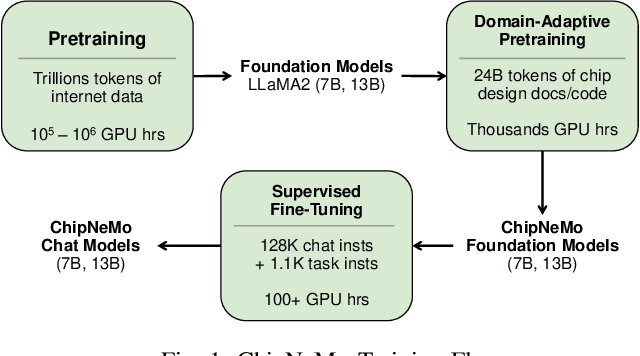
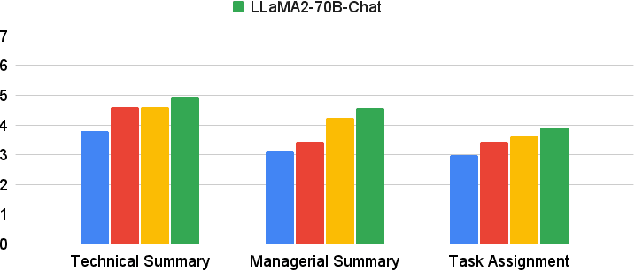
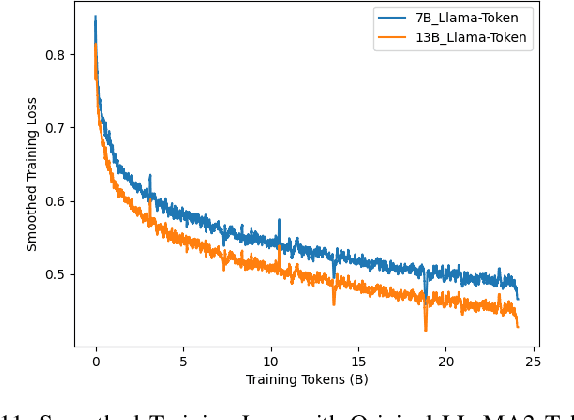
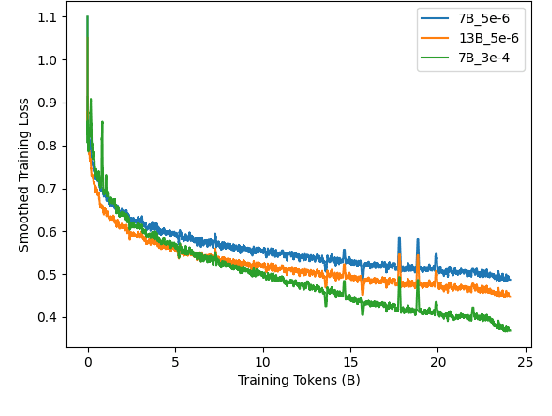
Abstract:ChipNeMo aims to explore the applications of large language models (LLMs) for industrial chip design. Instead of directly deploying off-the-shelf commercial or open-source LLMs, we instead adopt the following domain adaptation techniques: custom tokenizers, domain-adaptive continued pretraining, supervised fine-tuning (SFT) with domain-specific instructions, and domain-adapted retrieval models. We evaluate these methods on three selected LLM applications for chip design: an engineering assistant chatbot, EDA script generation, and bug summarization and analysis. Our results show that these domain adaptation techniques enable significant LLM performance improvements over general-purpose base models across the three evaluated applications, enabling up to 5x model size reduction with similar or better performance on a range of design tasks. Our findings also indicate that there's still room for improvement between our current results and ideal outcomes. We believe that further investigation of domain-adapted LLM approaches will help close this gap in the future.
Automatic Routability Predictor Development Using Neural Architecture Search
Dec 03, 2020

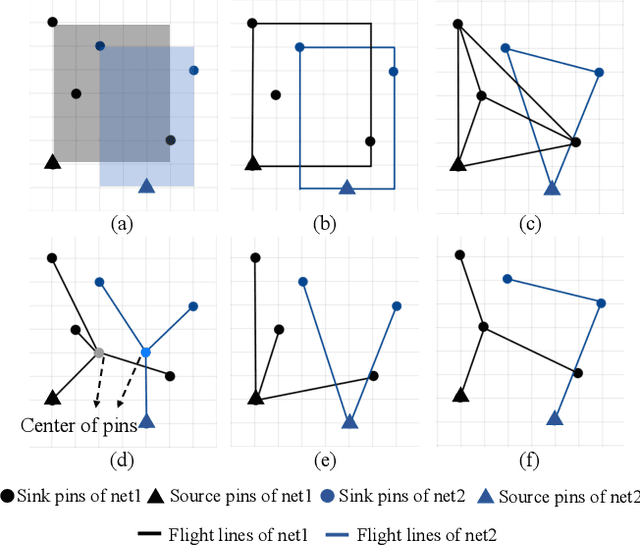
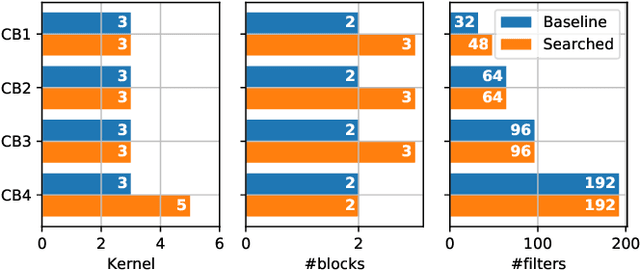
Abstract:The rise of machine learning technology inspires a boom of its applications in electronic design automation (EDA) and helps improve the degree of automation in chip designs. However, manually crafted machine learning models require extensive human expertise and tremendous engineering efforts. In this work, we leverage neural architecture search (NAS) to automatically develop high-quality neural architectures for routability prediction, which guides cell placement toward routable solutions. Experimental results demonstrate that the automatically generated neural architectures clearly outperform the manual solutions. Compared to the average case of manually designed models, NAS-generated models achieve $5.6\%$ higher Kendall's $\tau$ in predicting the number of nets with DRC violations and $1.95\%$ larger area under ROC curve (ROC-AUC) in DRC hotspots detection.
Net2: A Graph Attention Network Method Customized for Pre-Placement Net Length Estimation
Nov 27, 2020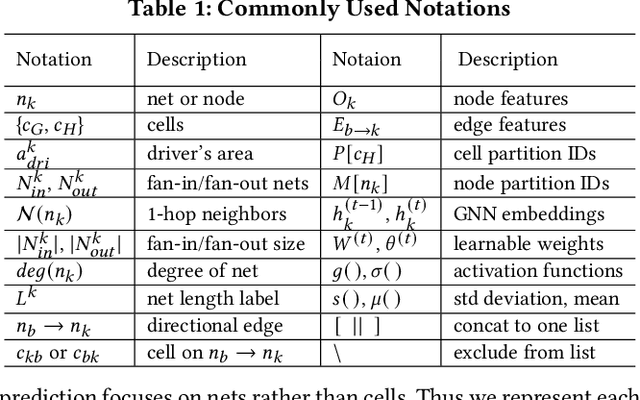
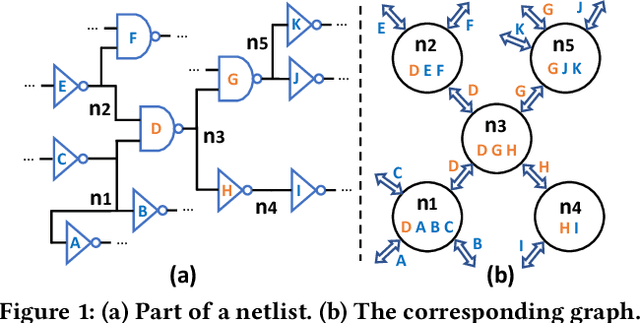
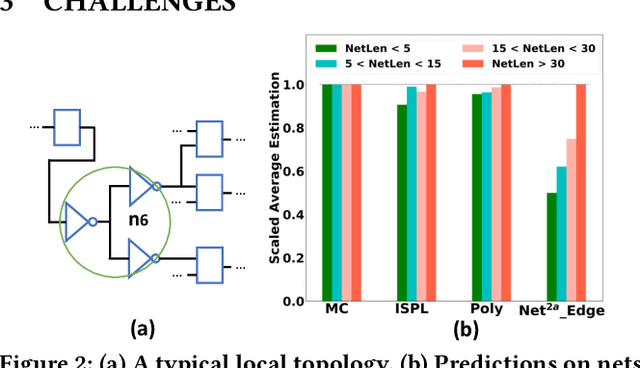
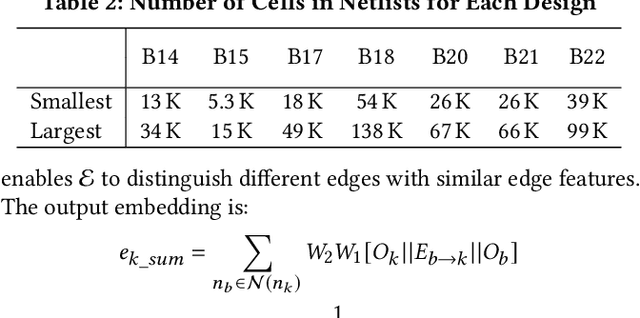
Abstract:Net length is a key proxy metric for optimizing timing and power across various stages of a standard digital design flow. However, the bulk of net length information is not available until cell placement, and hence it is a significant challenge to explicitly consider net length optimization in design stages prior to placement, such as logic synthesis. This work addresses this challenge by proposing a graph attention network method with customization, called Net2, to estimate individual net length before cell placement. Its accuracy-oriented version Net2a achieves about 15% better accuracy than several previous works in identifying both long nets and long critical paths. Its fast version Net2f is more than 1000 times faster than placement while still outperforms previous works and other neural network techniques in terms of various accuracy metrics.
 Add to Chrome
Add to Chrome Add to Firefox
Add to Firefox Add to Edge
Add to Edge